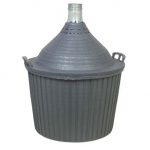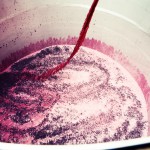Newbie Winemaker Gifts
Do you have a newbie winemaker in your life you need to get a gift for?
Maybe you are the newbie winemaker, and you need to know what to ask for this holiday season!
Either way, we have prepared a basic gift buying guide for you, to simplify the just-getting-started-winemaking process!
1. CARBOYS. The average home winemaker will never complain about having too many carboys – it just means more vessels to make wine in! You can get them in 3, 5, or 6 gallon formats. It’s always a good idea to get one of each to help accommodate varying volumes.
2. DEMIJOHNS. A more traditional vessel to make wine in, these can hold more volume AND not to mention it, but they are pretty cool looking. You can get them with or without a spigot at the bottom.
3. REFRACTOMETER. These devices are used to check the amount of sugar in grapes, and are indispensable to the serious home winemaker who is also starting to grow their own grapes as well – it helps to tell them when they should harvest!
4. OAK CHIPS. As a great way to play around with flavor, oak chips help the newbie winemaker to get a feel for what oak does to a wine as it ages without the investment in, and care for a full sized barrel. There’s a lot to learn when it comes to proper barrel maintenance, so adding oak chips is a perfect way to get the color and flavor dynamics of working with oak.
5. SIPHON. If your newbie winemaker wants to move beyond using a funnel or mouth siphoning to transfer their wine, an autosiphon will help to elevate them to the next level. It’s going to make their life a lot less messy and will take up less of their time to move their wine from vessel to vessel.
6. GIFT CERTIFICATE. Last but not, least! Purchase a gift certificate and your winemaker can put it towards anything they want. Classes, equipment, grapes, juices, you name it!
Musto Wine Grape Company is here to help! We are New England’s largest supplier for home winemaking products and services. You can get set up with all of your juice, grape and equipment needs and have you on track to making your own perfect pairing for next fall! Visit juicegrape.com or give us a call at (877) 812 – 1137 to learn more. We look forward to hearing from you!
The Winemaker’s Think Tank: Vol 22 – Seven Most Common Winemaking Mistakes
What’s the Winemaker’s Think Tank?
Every Thursday we will post about a few frequently asked questions that our winemaker has answered. If you have a winemaking question you would like to have answered, please email us at support@juicegrape.com and we will try to get into next week’s post. Cheers! 🙂
Seven Most Common Winemaking Mistakes
1. Headspace – When making wine, it is imperative that any vessel being used is filled completely. Filling carboys, demijohns, or fixed capacity tanks to the highest level possible, minimizing any air space it very important to prevent oxidation. If using a barrel, the barrel will allow for some evaporation as the wine ages. It is critical to top of the barrel with additional wine as this will prevent the oxidation of the wine in the barrel. Barrels do promote a small amount of oxidation, referred to as micro-oxidation, which is helpful at creating a creamier mouthfeel and promoting the expression of fruit flavors and aromas. If a large headspace develops due to evaporation, this can cause severe oxidation in the wine.
2. Degassing– Carbon dioxide gas is a byproduct of the yeast during alcoholic fermentation. Often times the bubbles of SO₂ are so small, they get trapped by the weight of the wine. If the wine is not purposefully degassed, the bubbles may come out of solution in the bottle, resulting in a fizzy wine for the drinker. The degassing process is relatively simple. One may purchase a degassing tool that is attached to a cordless power drill and stirs the wine at a high speed, agitating it and releasing the trapped bubbles. The winemaker can also splash the wine while racking, agitating the wine and releasing the trapped bubbles of gas. As long as the wine has been stirred vigorously, the gas should dislodge and escape, ensuring that it will not be fizzy in the bottle.
3. Sanitation – This may be the most important step in all of winemaking. While cleaning and sanitizing may be a tedious and time consuming process, it is critical to ensure a healthy, long lasting wine. There are an assortment of cleaning agents (B-Brite, Soda Ash, Sterox) that are excellent at cleaning wine making equipment and removing stains. These products need to be rinsed off thoroughly and should be thought of as “soap” rather than sanitizer. After the equipment has been washed and well rinsed, it must then be sanitized with potassium metabisulfite. A solution of 2 ounces of sulfite powder, dissolved into one gallon of water, will yield a strong sanitizing solution that will kill off any microbes that could spoil the wine. This will ensure the longevity of the wine in the aging vessel or bottle.
4. Bench Trials – When using a fining agent or oak additive to your wine, it is very important to first conduct a small trial of the product, before adding it to the entire batch. Assess the addition rate for the compound you would like to add to the wine. Using that as a guide for your ratio, pull out a small amount of the wine and add the compound, making sure that the ratio is accurate for that size sample. Allow the sample to sit for a few days and try it. If the results are what you were striving for, then you can apply the compound to the entire batch. This will help save you time and money if you are not satisfied with the results of the bench trial and will help you most effectively improve your wine.
5. Sulfites – Sulfites are a naturally occurring compound within wine. While sulfites do exist naturally, they are at a low level, not sufficient for helping to preserve the wine as an antioxidant. Additional potassium metabisulfite must be added to help prevent oxidation as well as prevent any advantageous microbes from growing in the wine. If the winemaker neglects to add sulfites to the wine, it will easily oxidize and could also be susceptible to bacterial contamination.
6. Record keeping – Often times with winemaking, “the devil is in the details”. The smallest change in yeast strain, nutrition, and grape acid and sugar content, can have dramatic effects on the resulting wine. The best winemakers, on the home or professional level, take meticulous notes on all of their activities and observations. By keeping track of each step of their process, they are able to reproduce their very best wines and also do research on what went wrong with their failures.
7. Timing – It is said that timing is everything. This is particularly true for winemaking. Many folks assume after fermentation, they can just leave the wine alone to age and it will come out beautifully if untouched. This is not the case. The wine needs to be maintained with racking and sulfites to ensure its longevity. Sometimes in winemaking, a fault may develop, Rather than researching a way to fix the fault or seek some professional advice, some winemakers elect to do nothing and hope the fault goes away. Often times, these faults progress and get worse. If caught early, they can be easier to fix.
We hope this information helps with your winemaking. If you have any follow up questions or winemaking questions in general, please email us at support@juicegrape.com.








Recent Comments